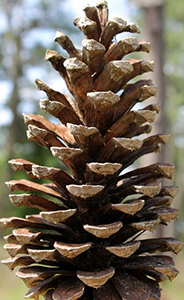Introduction
The tiny, mighty seed. Have you ever held a seed in your hand and imagined how big it will become? An acorn growing to a large oak? The winged seed of a pine becoming a towering giant of the forest? The little pepper seed that fuels the spice of our dinner plates? Seeds come in many different shapes and sizes, but they also play a major role in ecological function and agricultural production.
The Seed Bearers
Seeds are the products of sexual reproduction for seed-bearing plants: gymnosperms and angiosperms. Gymnosperms use cones for seed production while angiosperms use flowers. Pollination is a critical step in seed production. Some plants have both male and female parts on one plant (monecious), while some plants are either male or female (dioecious). Therefore, some plants can self-pollinate while others may require a male and female plant.
Gymnosperms use cones for reproduction. For example, the Longleaf Pine (Pinus palustris) monecious and has both male and female cones on the same tree. The male cones release pollen that fertilizes female cones. After a couple years the female cones grow and develop seeds – soon to be released. Similarly, angiosperms’ pollen from the male flowering parts fertilizes the female flowering parts. The resulting ovary develops into fruits, which houses the seeds.


Seed Groups
Seeds come in many different sizes and forms. The largest seed is the Double Coconut (Lodoicea maldivica), while the smallest seed is the Orchid (not a mustard seed). Despite the size, there are three major seed groups: Naked-Seeds, Monocots, and Dicots.
Naked-Seeds form within gymnosperm cones. Unlike angiosperms’ seeds, the gynosperms’ naked seeds are not contained within a fruit and protected by the cone scales on a leaflike structure called megasporophylls.
We categorize angiosperms into two different categories: dicots and monocots. There are many physiological differences between dicots and monocots, including their seeds. Their seed differences are determined by the number of cotyledons within the seed’s embryo (Cotyledons are the first “leaves” of the plant, referred to as “seed leaves”). Monocots have one cotyledon while dicots have two cotyledons.

Ecological Function of Seeds
Seeds play a pivotal role in ecological function. Plants’ evolutionary adaptations improve their seed dispersal methods. Seed dispersal adaptations are an important component in maintaining ecosystem biodiversity. Many adaptations include wind, animal, water, explosion, and fire. Fire seed dispersal adaptations are important for Florida ecosystems. Some pines rely on fire to melt pinecone resin. As fire passes through a natural area, the pinecones’ resin melts, which opens and releases seeds to a recently disturbed landscape. Therefore, without fire, the entire ecosystem would change.
Agricultural Function of Seeds
Much of agriculture is dependent on seeds for food production. Both farmers and gardeners collect and store seeds for future plantings. A strong diversity of available seeds ensures resilient crops for food production. Similarly, seed collection of important pollinator plants, such as Florida’s wildflowers is great for helping provide pollinator habitat. Additionally, increased pollinator habitats help with agricultural crop production and even pest management.
Seeds Saving for the Gardeners
Seed saving is a common hobby among home gardeners. These seed savers collect, store, and share seeds from their gardens and it is very easy to do. Store any seeds you collect in a cool, dry location. We recommend storing seeds in labeled paper envelopes and glass jars. You may place the seeds in your refrigerator. Be aware though, seeds do not like moisture or humid conditions – this will significantly reduce the shelf-life of your seeds. For more information about seed saving, check out the great blog post from UF/IFAS Extension Orange County’s Tia Silvasy
In Conclusion
From the largest seed of the Double Coconut to the smallest seed of an Orchid, our environmental quality and food accessibility are dependent on the tiny, mighty seed. So next time you see a seed drift through the air, hug your pant’s leg, or get carried off by a squirrel, always remember big things come in small packages. And remember to say thanks to the tiny, mighty seed.
MORE BLOGS!!!
Interested in more Blogs from Dr. Taylor Clem? Check out his blogpage
Also check out our…
 0
0
